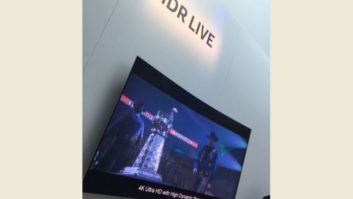Technology can be made to advance by order of the government. That’s a misguided tenet that appears to be deeply entrenched in the minds of our national leadership in Washington.
The newest manifestation of this “we know better than the engineers and marketers” attitude is the FCC order issued last month requiring that by July 31, 2007, all 13-inch and larger color TVs be equipped with tuners capable of receiving digital TV broadcasts.
This is all too reminiscent of the congressional mandate that all TVs be equipped with both VHF and UHF tuners by 1964. That order was the result of demands by the new UHF broadcasters who were complaining they were unable to attract a big enough audience, as most sets of the time were VHF-only. What’s more — and this may sound familiar — at the time the idea of “transitioning” all VHF broadcasters to UHF was also being kicked around.
The FCC, following Congress’ orders and relying on assurances from one independent tuner manufacturer, established standards for UHF tuners that included a severe limit on RF radiation emissions.
As the deadline approached it became clear that the manufacturer would not be able to produce enough tuners for the entire industry, and that neither it, nor any of the other tuner makers, including TV manufacturers who made their own, would be able to meet the standards. The result was that while all sets did have UHF as well as VHS tuners, they were able to come to market only because the FCC granted waivers of the standard.
The waiver request became an almost annual event for several years. UHF broadcasters were still unsatisfied. In 1968 they demanded functional tuner equality. While VHF tuners were click-stop from channel to channel, most UHF tuners were smooth, like radio tuners. So in 1969 the FCC, again relying on the assurances of that same independent tuner maker, ordered that UHF tuners be click-stop too.
Most communities only had one or two UHF stations, so the smooth tuning was fast and relatively simple. But a click-stopping from, say, channel 14 to channel 50 was a major pain in the wrist, and then you had to fine tune anyway. And of course the tuner makers couldn’t deliver, and again waivers were needed.
Fortunately, the tuning issue was resolved in the 1970s with the emergence of electronic tuning.
That the FCC is correct that, down the line, digital tuners won’t add anything like the $200 the industry is claiming, doesn’t change the fact that the whole ruling is cockeyed. By staggering production requirements, the FCC is assuring that, unless the industry voluntarily speeds up adoption, fewer than half of all TV reception-capable products will have digital tuning before the final deadline. That lack of high-volume digital tuner production is a guarantee of a high price for the feature.
In arguing the need for the rule Chairman Michael Powell trips all over his statistics. He says “There are approximately 81 million television sets in the U.S.” — over 30 percent of the total — “that are not connected to any subscription video service and rely solely on free, over-the-air broadcasting.” He further states that 46.5 million are in over-air only homes and “34.5 million are in homes that subscribe to a multichannel video programming service.” So which is it, they subscribe or they don’t?
It also was made very clear by Powell that the hard and fast deadline of Dec. 31, 2006 for broadcasters to “transition” is far from etched in stone. Noting that this is “a government-mandated expiration date for analog TV broadcasting,” Powell states firmly that “Someday, analog broadcasting will cease.”
And as Snow White says, “Someday my prince will come.”











